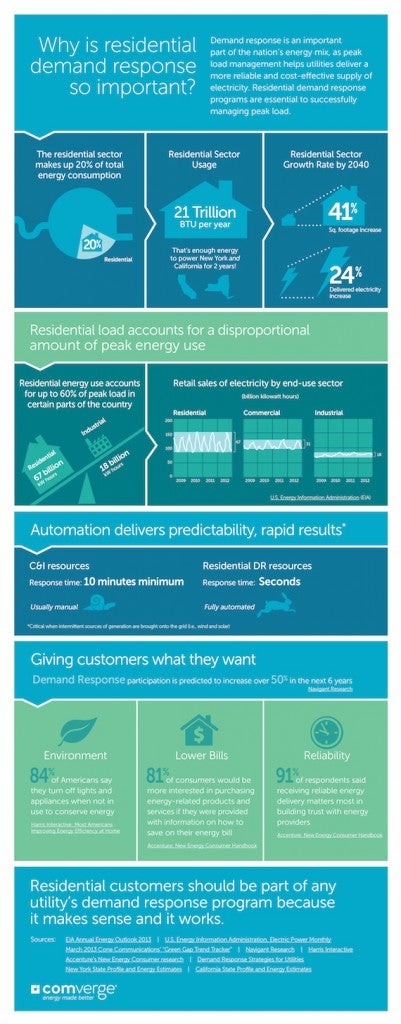Why Residential Demand Response Is a Critical Part of Our Nation’s Energy Mix
Guest Blog Post By: R. Blake Young, President and CEO of Comverge
The complex task of managing peak energy demand is not something that should be addressed in a piecemeal fashion, and this is particularly true in the demand response industry. For reference, demand response (DR) balances supply and demand, providing peaking capacity to utilities without investments in new plants. DR incentivizes change in customer energy usage patterns to reward lower electricity use at times when system reliability is jeopardized or the price of electricity is higher.
While Comverge supports both residential and commercial and industrial (C&I) demand response programs, it’s important to remember that the residential sector is an incredibly valuable and essential part of any energy management program. The infographic below illustrates why residential demand response is so important to our nation’s energy mix.
Residential Energy Consumption is Increasing & Comprises a Disproportionate Amount of Peak Energy Use
According to the U.S. Energy Information Administration’s (EIA) 2013 Annual Energy Outlook, the residential sector currently makes up 20 percent of total energy demand. In addition, total residential square footage in the U.S. is expected to increase by approximately 41 percent by 2040, bringing the total delivered electricity up as well.
It’s clear that residential energy use makes up a sizeable portion of the energy pie, but interestingly it accounts for over 50 percent of peak energy load in certain parts of the country. Since demand response was initially created to manage peak load, the residential segment simply can’t be ignored as part of any utility’s energy management strategy.
The Value of Predictability
Being able to manage peak load is one thing, but being able to do so at the touch of a button offers a whole different level of reliability and predictability. This provides utilities with a rapidly-dispatchable resource that delivers guaranteed results – which is especially critical as utilities add more variable sources of generation to the grid like wind and solar. Bottom line: residential demand response delivers energy relief to the grid that is always available when it’s needed. Furthermore, the speed at which the energy reduction can be achieved is remarkable.
Consumers Want to Manage their Energy Use
Residential demand response gives customers what they want by helping to address environmental concerns, enhancing communications and providing a wide range of choices. This is important as people don’t just want to monitor energy use; they also increasingly want to engage with their utility on their energy consumption. A residential demand response program provides a great tool for utilities to engage with their residential customers, and can be an inflection point to start thinking about participation in other energy management programs available to them.
So, why does residential demand response matter? Because it makes sense, and it has proven to be a critical part of our nation’s energy mix.












2 Comments
The ability to call on residential and commercial demand response should be a part of our national energy policy. It’s effective, inexpensive to deploy, and painless to the energy consumer. (Far less painful than a blackout!) It’s also an extremely clean method in helping to ensure grid reliability—and who doesn’t love clean energy these days. It has worked very well in states that have adopted demand response as part of their energy management mix.
Legislation requiring the nationwide deployment of residential and commercial demand response programs—while the smart grid is still being developed and deployed—should be seriously considered. Demand response works.
Here’s an interesting article regarding DR pilots and programs around the world: http://www.fierceenergy.com/story/energy-demand-driving-dr-asia-pacific/2013-11-26?utm_medium=nl&utm_source=internal